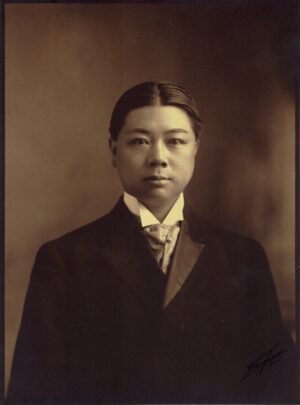
The story of Look Tin Eli begins in Mendocino, California, in 1870. Born and raised on the rugged headlands of the north coast, as a child Tin could stand 70 feet above the pounding surf and look out over the Pacific Ocean, watching steamers and schooners coming in and out of Mendocino Bay below him.
At this time, Mendocino was a small shipping port for lumber, which was hauled out of the forested mountains with great effort by men and beasts and floated down Big River to be cut at the mill. As the lumber was brought across the headlands on the company’s tramway to the shipping point for delivery to San Francisco and the world beyond, it traveled past the Chinese houses and stores in Mendocino’s Chinatown where Look Tin Eli lived.
Tin’s Chinese-born father was known as Eli Tia Key. He initially worked as a cook for logging contractor Daniel Milliken, but around 1870, he started a general merchandise store in Mendocino. His store’s advertisements appeared for years in the Mendocino Beacon, offering tobacco, rice, cigars, tea, boots, shoes, clothing, and many other items for sale.
The three-story store, which was also their home, stood for more than 40 years, until a fire destroyed it in 1911. It was located at the west end of town near the shipping point, on the south side of Main Street. This was one of four areas around town where old Sanborn-Perris fire insurance maps tell us Chinese people had dwellings and businesses in and among the rest of the town buildings during the late 1800s. While the Chinese in Mendocino operated several general merchandise stores, herbs shops, and hand laundries, the land and the buildings belonged to whites because Chinese in California were not allowed to own real estate at this time, and their children could not attend public schools.
Look Tin Eli came of age during an era of intense anti-Chinese sentiment, when many laws were enacted to prevent non-whites from coming to the United States, forcibly remove them from frontier settlements, and exclude them from ever becoming American citizens, as European pioneers and their children were allowed to do.
Mendocino-born Look Tin Eli challenged these laws, and helped to establish that all people who were born in the U. S. were Americans by birth, no matter the color of their skin.
But still, 166 years after the Declaration of Independence stated that all men are created equal, and 74 years after the United States Civil War won citizenship for people of African descent, our country, in 1942, revoked the constitutional rights of thousands of its Japanese American-born citizens by removing them from their homes and imprisoning them for three years during World War II. Japanese families living in Mendocino County were affected by this racial injustice.
The new Kelley House Museum exhibit, The Story of Look Tin Eli: Exclusion and Citizenship on the Mendocino Coast, begins with one Chinese-American man’s fight for citizenship, brings us through the early years of overt anti-immigrant laws directed at the Chinese, and up to the 1940s when Japanese-Americans still struggled for the rights of full citizenship in America.
This thought-provoking exhibit runs through July 22, and is accompanied by two presentations. On Sunday June 2, at 4:00, the authors of the exhibit, Jane Tillis and Lorraine Hee-Chorley, will give a talk on the Chinese in Mendocino. On Sunday June 23, at 2:00, the Museum will show the PBS documentary, “The Chinese Exclusion Act.” Donations are requested. For more information call 707/937-5791, or visit our website: kelleyhousemuseum.org.